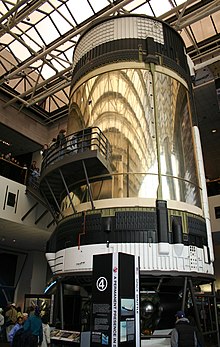Skylab B
Skylab B was a concept for a second US space station based on the same basic principle as Skylab . It was planned by NASA for a variety of purposes, mainly for the Apollo Soyuz Test Project (ASTP), but was abandoned due to funding problems. McDonnell Douglas built two Skylabs for the Skylab program in 1970, originally the Apollo Application Program. The first was launched into space in 1973. The second was put into storage and named Skylab B.
plans
Many plans for Skylab B included putting the station in a state where artificial gravity was created. There were also considerations for the 200th anniversary of the USA in 1976 to start two Soviet Soyuz missions to replace the Skylab.
When the ASTP was initiated in 1972, NASA wanted to launch Skylab B in 1975 during the ASTP mission. A docking maneuver between the Apollo and the Soyuz spacecraft and the execution of previously planned operations were planned. Then Skylab B should be flown to, which was called “International Skylab” during the discussion about ASTP. There the mission should be extended by 56 to 90 days.
For the future, there were plans to expand the station with the space shuttle starting in 1981 , after the first Skylab would re-enter the earth's atmosphere in 1979. At the time this idea was discussed, NASA still had two Saturn V rockets, three Saturn 1B rockets, Skylab B, three Apollo spacecraft, and two Apollo lunar lander in storage.
After Skylab was started in May 1973, the plan for Skylab B was discarded. The ASTP therefore had to use the docking module for experiments. After the Apollo program ended and NASA began developing the space shuttle, the excess parts from Apollo were donated to museums in December 1976. If Skylab B had been launched as intended, it would have been the second own space station built by the USA.
Skylab B is now available for viewing at the National Air and Space Museum in Washington, DC .
Web links
- Skylab B in the Encyclopedia Astronautica (English)
swell
- Frieling, Thomas J, Quest , "Skylab B: Unflown Missions, Lost Opportunities," 1996, Volume 5, Issue 4, page 12.
